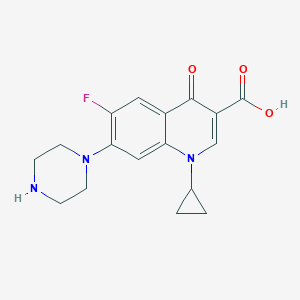Lower respiratory tract infections, Skin and soft tissue infections, Upper respiratory tract infections
Adult: 400 mg bid to tid via infusion over 60 minutes for 7-14 days.
Intravenous
Malignant otitis externa
Adult: 400 mg tid via infusion over 60 minutes for 28 days up to 3 months.
Intravenous
Bone and joint infections
Adult: 400 mg bid to tid via infusion over 60 minutes. Max treatment duration: 3 months.
Intravenous
Treatment and postexposure prophylaxis of inhalation anthrax
Adult: 400 mg bid via infusion over 60 minutes for 60 days from the confirmation of Bacillus anthracis exposure.
Child: 10-15 mg/kg bid via infusion over 60 minutes for 60 days from the confirmation of Bacillus anthracis exposure. Max dose: 400 mg/dose.
Child: 10-15 mg/kg bid via infusion over 60 minutes for 60 days from the confirmation of Bacillus anthracis exposure. Max dose: 400 mg/dose.
Intravenous
Pyelonephritis, Urinary tract infection
Adult: 400 mg bid to tid via infusion over 60 minutes for 7-21 days or longer if needed.
Child: 6-10 mg/kg tid via infusion over 60 minutes for 10-21 days. Max: 400 mg/dose.
Child: 6-10 mg/kg tid via infusion over 60 minutes for 10-21 days. Max: 400 mg/dose.
Intravenous
Acute prostatitis
Adult: 400 mg bid to tid via infusion over 60 minutes for 2-4 weeks.
Intravenous
Intra-abdominal infections
Adult: 400 mg bid to tid via infusion over 60 minutes for 5-14 days.
Intravenous
Epididymo-orchitis, Pelvic inflammatory disease
Adult: In patients with ciprofloxacin-susceptible N. gonorrhoeae infection: 400 mg bid to tid via infusion over 60 minutes for at least 14 days.
Intravenous
Typhoid fever
Adult: 400 mg bid via infusion over 60 minutes for 7 days.
Intravenous
Diarrhoea
Adult: 400 mg bid for 1-5 days depending on the severity and nature of infection, given via infusion over 60 minutes. Refer to detailed product guideline.
Intravenous
Cystic fibrosis
Child: 10 mg/kg tid for 10-14 days. Max: 400 mg/dose.
Ophthalmic
Superficial ocular infections
Adult: As 0.3% ophth solution: Instill 1 or 2 drops onto affected eye(s) 4 times daily. Severe infections: Instill 1 or 2 drops 2 hourly for 2 days during waking hours, then 4 times daily thereafter. Max treatment duration: 21 days. As 0.3% ophth ointment: Apply approx 1/2 inch ribbon into the conjunctival sac onto the affected eye(s) tid for 2 days, then bid for the next 5 days.
Child: ≥1 year As 0.3% ophth solution: Same as adult dose. ≥2 years As 0.3% ophth oint: Same as adult dose.
Child: ≥1 year As 0.3% ophth solution: Same as adult dose. ≥2 years As 0.3% ophth oint: Same as adult dose.
Ophthalmic
Corneal ulcer
Adult: As 0.3% ophth solution: Initially, instill 2 drops onto affected eye(s) every 15 minutes for the 1st 6 hours, then every 30 minutes thereafter on day 1. Then, instill 2 drops onto affected eye(s) hourly on day 2. Thereafter, instill 2 drops onto affected eye(s) 4 hourly on days 3-14. Max treatment duration: 21 days.
Child: ≥1 year Same as adult dose.
Child: ≥1 year Same as adult dose.
Oral
Treatment and postexposure prophylaxis of inhalation anthrax
Adult: 500 mg bid for 60 days from the confirmation of Bacillus anthracis exposure.
Child: 10-15 mg/kg bid. Max: 500 mg/dose for 60 days from the confirmation of Bacillus anthracis exposure.
Child: 10-15 mg/kg bid. Max: 500 mg/dose for 60 days from the confirmation of Bacillus anthracis exposure.
Oral
Lower respiratory tract infections, Skin and soft tissue infections, Upper respiratory tract infections
Adult: 500-750 mg bid for 7-14 days.
Oral
Malignant otitis externa
Adult: 750 mg bid for 7-14 days up to 3 months.
Oral
Typhoid fever
Adult: 500 mg bid for 7 days.
Oral
Prostatitis
Adult: 500-750 mg bid. Treatment duration: 2-4 weeks (acute); 4-6 weeks (chronic).
Oral
Pyelonephritis
Adult: Patients with uncomplicated cases: 500 mg bid for 7 days (immediate-release); 1,000 mg every 24 hours for 7-14 days (extended-release). Patients with complicated cases: 500-750 mg bid for at least 10 or up to 21 days if required.
Child: Patients with complicated cases: 10-20 mg/kg bid for 10-21 days. Max: 750 mg/dose.
Child: Patients with complicated cases: 10-20 mg/kg bid for 10-21 days. Max: 750 mg/dose.
Oral
Uncomplicated cystitis
Adult: 250-500 mg bid for 3 days (immediate-release); 500 mg every 24 hours for 3 days (extended-release).
Oral
Cystic fibrosis
Child: 20 mg/kg bid for 10-14 days. Max: 750 mg/dose.
Oral
Complicated cystitis
Adult: 500 mg bid for 7 days (immediate-release); 1,000 mg every 24 hours for 7-14 days (extended-release).
Child: 10-20 mg/kg bid for 10-21 days. Max: 750 mg/dose.
Child: 10-20 mg/kg bid for 10-21 days. Max: 750 mg/dose.
Oral
Bone and joint infections
Adult: 500-750 mg bid. Max treatment duration: 3 months.
Oral
Epididymo-orchitis, Pelvic inflammatory disease
Adult: In patients with ciprofloxacin-susceptible N. gonorrhoeae infection: 500-750 mg bid for at least 14 days.
Oral
Diarrhoea
Adult: 500 mg bid for 1-5 days depending on the severity and nature of infection. Refer to detailed product guideline.
Oral
Intra-abdominal infections
Adult: 500-750 mg bid for 5-14 days.
Oral
Gonococcal cervicitis, Gonococcal urethritis
Adult: In patients with ciprofloxacin-susceptible N. gonorrhoeae infection: 500 mg as a single dose. Refer to local guidelines.
Oral
Prophylaxis of meningococcal meningitis
Adult: 500 mg as a single dose.
Otic/Aural
Acute otitis externa
Adult: As 0.2% otic solution: Instill 0.25 mL into the affected ear(s) bid for 7 days. As 6% otic susp: Instill 0.2 mL into the affected ear(s) as a single dose.
Child: ≥1 year As 0.2% solution: Same as adult dose. ≥6 months As 6% otic susp: Same as adult dose.
Child: ≥1 year As 0.2% solution: Same as adult dose. ≥6 months As 6% otic susp: Same as adult dose.
Otic/Aural
Bilateral otitis media with effusion
Child: In patient undergoing tympanostomy tube placement: ≥6 months As 6% otic susp: Instill 0.1 mL intratympanically into the affected ear(s) as a single dose following suctioning of middle ear.




 Sign Out
Sign Out




